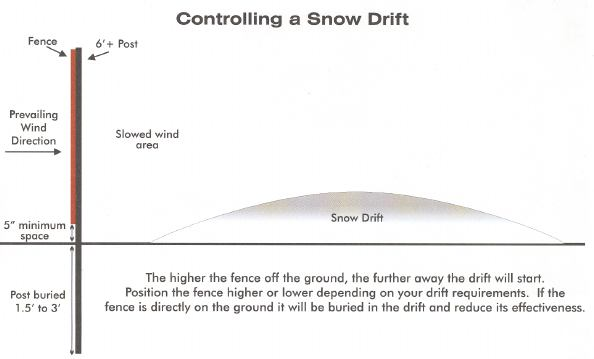I’m sure many of you have seen snow fences before but chances are you may not know their actual purpose, how they work, or how to properly set them up. A common misconception is that snow fences will keep the snow off your property or stop drifts from forming and that is not the case. Snow fences do however give you control over where the snow accumulates and where drifts form. Installing a snow fence improperly can actually cause bigger drifts or make little difference compared to your current situation. I’ve found a great source below to help guide you in installing a snow fence properly to help you this winter.

An article by US Netting offers some useful insight on preparing a snow fence as well as maintaining one.
Research, determine variables
Snow fencing is designed for snow storage. A thorough knowledge of the problem is needed to estimate a sound solution.
- Wind Direction – This information can be found in meteorological data from weather stations, by examining drift features in area or aerial photographs, and by checking the orientation of vegetation, such as bent trees or snow-caused abrasion on wooden poles.
- Snow Transport – Estimate from wind speed records in the area. Keep in mind that in winds of less than 20 mph, 90% of the blown snow stays below 4 ft. In winds of less than 45 mph, 70% of the blowing snow remains below the 4 ft. mark.
- Snow Fall – Look up the records for past years and estimate snow fall records for the problem area.
Design
Design is critical to installing the most effective snow fencing for the area.
- Porosity refers to the open area of a fence. A porosity of 40-50% is recommended to form the largest drifts.
- Bottom Gap should be 10 – 15% of the fence height. Although in rough terrain or snow covered areas the bottom gap may be higher. This makes the fence less likely to be buried.
- Windy Conditions warrant the use of ties or wood strips to attach the fence to wood posts (see illustration).
- Anchoring the fence firmly is a necessity. In good soil, a six-foot fence post should be buried 2-1/2 ft.
Placement
Correct placement is essential in installing effective snow fencing. Incorrect placement can make the snow drift problem worse. Fence posts should be spaced no more than 8 feet apart for 4 ft. snow fences. End posts should be 6 ft. or less from the adjacent post. The end post placement facilitates bracing.
- Row – A drift can spread as far as 35 times the height of the fence. Therefore, the fence must be at least that far from the roadway and the distance may be farther because of irregular terrain. Also build the fence longer than the area that needs to be protected. Add 20 times the height of the fence on each end to account for wind variation.
- Alignment – Generally place the fence parallel to the road if the wind is within 25 degrees of being perpendicular to the roadway. If the wind direction is parallel to the road, fences should be placed perpendicular to the prevailing wind direction. Placement may vary up to 25 degrees to avoid adverse terrain or to take advantage of favorable topography.
- Multiple Rows – To avoid fence burial downwind leave 25 times the height in open area for snow drifts to form. With staggered fencing, make sure that all gaps are covered with following rows.

Proper installation is critical. Snow fence should be positioned upwind of the desired drift area, noting the prevailing wind direction. Posts should be strong as they will be the weakest link where tensile strength is concerned (metal U-posts should not be used). Bury posts 1/3 their height and place no more than 8 feet apart. The fence should be pulled taught, and support wires should stabilize end posts to prevent sagging. Fence should be attached to the upwind side of the post to minimize tearing. There should be a 5″ minimum gap at the bottom of the fence to prevent burying. The higher the fence from the ground, the further away the drift will start.
You can find the full article here: https://www.usnetting.com/fence/snow-fence/installation/
Subscribe to our YouTube channel, our Facebook page, and also our blog page on our website to stay up to date on what’s happening at Delta Fence & Construction! We will be posting useful content just like this periodically to help you become more educated fence owners. Stay tuned for more!
Like us on Facebook: https://www.facebook.com/DeltaFence/
Subscribe to our blog page: https://www.deltafenceman.com/blog/
Subscribe to our YouTube channel: https://www.youtube.com/user/deltafenceman
For more information on your new fencing project or any other questions you may have, reach out to us by calling (906) 786-1076.
